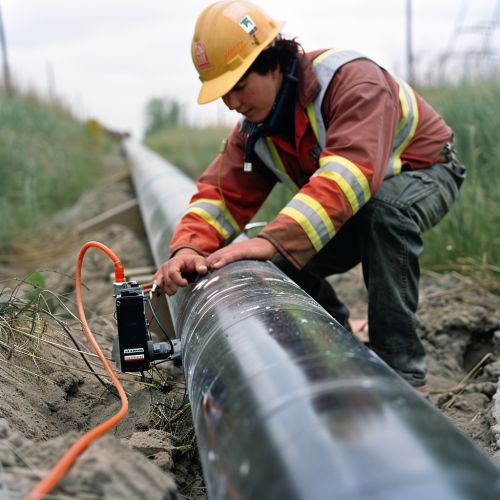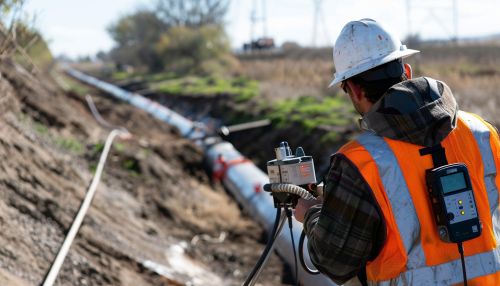Leak Detection
Introduction
Leak detection is a critical process in various industries, ensuring the integrity and safety of systems and preventing environmental damage. This article delves into the methodologies, technologies, and applications of leak detection, providing a comprehensive overview for experts and practitioners in the field.
Methods of Leak Detection
Leak detection methods can be broadly categorized into physical, chemical, and electronic techniques. Each method has its advantages and applications, depending on the type of system and the nature of the leak.
Physical Methods
Physical methods involve direct observation or measurement of leaks. These include:
- **Visual Inspection**: The simplest form of leak detection, where inspectors look for visible signs of leakage, such as stains, drips, or puddles.
- **Bubble Test**: A method where a soap solution is applied to the suspected area, and the formation of bubbles indicates the presence of a leak.
- **Pressure Decay Test**: This involves pressurizing the system and monitoring the pressure over time. A drop in pressure indicates a leak.
Chemical Methods
Chemical methods use specific substances to detect leaks:
- **Tracer Gas Method**: Involves introducing a tracer gas, such as helium or hydrogen, into the system. The presence of the gas outside the system indicates a leak.
- **Dye Penetrant Inspection**: A dye is applied to the surface, and its penetration into cracks or leaks is observed under ultraviolet light.
Electronic Methods
Electronic methods employ advanced technologies for precise leak detection:
- **Ultrasonic Leak Detectors**: These devices detect the high-frequency sound waves produced by leaks. They are highly sensitive and can detect even small leaks.
- **Infrared Thermography**: This technique uses infrared cameras to detect temperature changes caused by leaks. It is particularly useful for detecting leaks in insulated systems.
- **Acoustic Emission**: This method monitors the sound waves generated by the rapid release of energy from a leak. It is effective for detecting leaks in pipelines and pressure vessels.
Applications of Leak Detection
Leak detection is vital in various industries, each with specific requirements and challenges.
Oil and Gas Industry
In the oil and gas industry, leak detection is crucial for preventing environmental contamination and ensuring the safety of operations. Techniques such as pigging, acoustic emission, and infrared thermography are commonly used.
Water Supply Systems
Leak detection in water supply systems helps in conserving water and reducing costs. Methods like pressure decay tests, acoustic leak detectors, and tracer gas methods are employed to identify and locate leaks.
Chemical and Petrochemical Industry
In chemical and petrochemical plants, leak detection is essential for preventing hazardous material releases. Techniques such as ultrasonic detectors, dye penetrant inspection, and infrared thermography are used to ensure the integrity of storage tanks and pipelines.
HVAC Systems
Heating, ventilation, and air conditioning (HVAC) systems require leak detection to maintain efficiency and prevent refrigerant loss. Methods like bubble tests, tracer gas, and electronic leak detectors are commonly used.
Advanced Leak Detection Technologies
Recent advancements in technology have led to the development of more sophisticated leak detection methods.
Fiber Optic Sensing
Fiber optic sensing involves embedding fiber optic cables along pipelines or structures. These cables detect changes in temperature, strain, and vibration, indicating the presence of a leak. This method provides real-time monitoring and precise location of leaks.
Satellite-Based Detection
Satellite-based leak detection uses remote sensing technology to monitor large areas for leaks. This method is particularly useful for detecting leaks in remote or inaccessible locations. It involves analyzing satellite imagery for signs of leaks, such as changes in vegetation or soil moisture.
Machine Learning and AI
Machine learning and artificial intelligence (AI) are increasingly being used to enhance leak detection. These technologies analyze large datasets from various sensors and identify patterns indicative of leaks. They improve the accuracy and efficiency of leak detection systems.
Regulatory and Safety Considerations
Leak detection is governed by various regulations and standards to ensure safety and environmental protection.
Regulatory Framework
Different countries have specific regulations for leak detection, particularly in industries like oil and gas, water supply, and chemical manufacturing. These regulations mandate regular inspections, maintenance, and reporting of leaks.
Safety Protocols
Implementing effective leak detection systems is crucial for maintaining safety. This includes regular training for personnel, adherence to safety protocols, and the use of appropriate personal protective equipment (PPE).
Challenges and Future Directions
Despite advancements, leak detection faces several challenges that need to be addressed.
Challenges
- **Detection Sensitivity**: Ensuring high sensitivity to detect even the smallest leaks.
- **False Positives**: Reducing the occurrence of false positives that can lead to unnecessary inspections and costs.
- **Environmental Factors**: Addressing the impact of environmental conditions on the accuracy of leak detection methods.
Future Directions
- **Integration of Technologies**: Combining multiple leak detection methods to enhance accuracy and reliability.
- **Development of New Materials**: Researching new materials that can improve the sensitivity and durability of leak detection sensors.
- **Enhanced Data Analytics**: Utilizing advanced data analytics and machine learning to improve leak detection and predictive maintenance.
Conclusion
Leak detection is a vital process across various industries, ensuring the safety, efficiency, and environmental integrity of systems. With continuous advancements in technology, the future of leak detection promises more accurate, reliable, and efficient methods.
See Also


